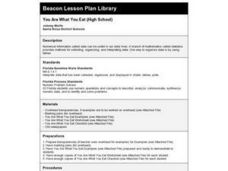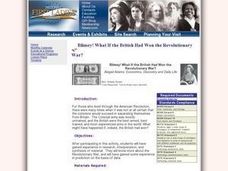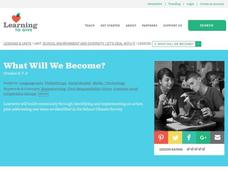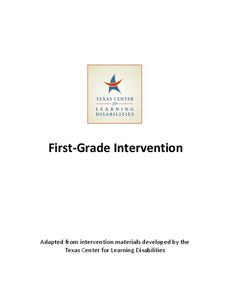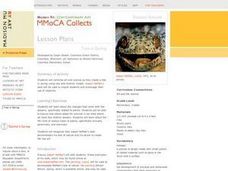Curated OER
You Are What You Eat (High School)
Students evaluate data from a statistical chart or graph which they find in a newspaper or magazine.
Curated OER
Making Public Policy
Eighth graders examine a Legislative website to view the biography of a member and a map of the district that the member represents. They are then visited by the member who engages students in a discussion about how legislators make...
Curated OER
The People of Kansas: Where Did They Come From and Why Did They Come?
Students research and discuss the reasons why early settlers emigrated to Kansas. They, in groups, analyze census district reports from the 1850's and then identify the advantages and disadvantages of using this information as research.
Curated OER
Watersheds, Watersheds Everywhere
Young scholars identify the watershed in which their school is located. They use maps to locate their homes and school. They define and use the correct vocabulary.
Curated OER
Gathering, Recording, and Presenting Data
Sixth graders use the local newspaper to find and discuss examples of uses of statistics and the ways in which the information is presented. They create and represent their own set of data showing how students get to school each day.
Curated OER
From Future Flight to Past Flight
Students complete a set of CD-ROM's to introduce them to the flight program at NASA. In groups, they research a topic related to flight and put their information on a CD-ROM. To end the lesson, they share their material with other...
Curated OER
Creative Problem Solving: Using the 5 W's (Who, What, Where, When, Why)
Third graders assimilate the use of the 5 W's (Who, What, Where, When, Why) when solving problems that are presented in literature and in real life situations. They use common fairy tales to solve problems that might arise at home or...
National First Ladies' Library
Building a Federal Town: Washington, DC
Young scholars create a timeline of the history of Washington, D.C. from 1787 to 1879. Using the internet, they read specified articles about the design of the capital and city of Washington DC. Students write a newspaper article about...
Curated OER
What Will We Become?
Middle schoolers create an action plan based upon the results of the School Climate Survey. They implement the plan as demonstrated by a daily log of activity. They complete group and individual reflection and evaluation activities.
University of Houston
Personal Narratives: Writing, Revising, and Publishing (WRAP)
Writing is a process, and lesson planning is, too! A personal narrative unit stresses the writing process to pupils, who first examine various stories and poems as a model of autobiographical writing and then write their own stories....
Scripps Ranch High School
The Crucible Journal Project
While reading Arthur Miller's The Crucible, start or end each day with a journal activity. The project includes a list of prompts for each act of the play. Pupils choose a prompt every time they write and connect their own experiences to...
Chicago Botanic Garden
Calculating Your Carbon Footprint
Unplugging from technology for one day per week will decrease your carbon footprint—are you up to the challenge? Part two in a series of three allows individuals to explore their personal carbon footprints. By first taking a quiz at home...
Nemours KidsHealth
Healthy Snacking: Grades 6-8
Two activities focus on healthy snacking. In the first activity, scholars create a poster displaying two messages—pack a healthy snack and make good food choices. The second activity challenges pupils to draft a snack list and tag along...
Department of Education (Ireland)
Decision Making
Think it through! That's the big takeaway from a series of lessons about decision-making. Young scholars engage in a series of exercises and activities designed to urge them to look at options, the pros, and cons of a course of action,...
Texas Center for Learning Disabilities
First-Grade Intervention
Learning how to read is a big challenge for young learners, but this series of lessons provides them with the extra support they need to succeed. With each lesson following the a clearly outlined format, children are introduced...
EngageNY
End-of-Module Assessment Task: Grade 8 Module 4
Connect proportional linear equations and systems. The seven-question assessment is the last installment in a 33-part series. The items cover comparing proportional relationships, slope concepts, and simultaneous linear...
Angel Island Immigration Station Foundation
Moving to the Poems of Angel Island
A poem carved on Angel Island's walls is the guiding text of a lesson that challenges scholars to put movement into a written piece of art. After warm up-activities, learners play a game of "Pass the Clap" and "Pass the Line," in which...
Nasher Museum of Art at Duke University
Are You My Mother? An Opinion Writing Unit
During a five-day lesson, scholars analyze written and visual art—primarily the poem, Mother to Son by Langston Hughes— identify facts, and write opinions. Learners read the poem several times, discuss, write, compare and...
Academy of American Poets
Teach This Poem: "Violin" by Nikki Wallschlaeger
Nikki Wallschlaeger's Violin is the featured poem in a lesson that uses music and multiple readings to delve deep into its analysis. After a writing warm-up, learners watch and listen to a video that showcases Regina Carter...
Curated OER
Reflection
The tenth lesson in the 12-part poetry unit asks seventh graders to reflect on their learning about poetry and share their work with other poets.
Curated OER
Understanding URLs
Ninth graders explore the different domain suffixes in the web site address, how to find the author or sponsor of a page to determine authority and accuracy. They determine how currency of a page. Students enter the lab, log onto...
Curated OER
My Neighborhood
Second graders discuss maps and identify boundaries found on a map. They walk through their school and nearby neighborhood and collect information regarding important features of the area.
Curated OER
Buildings, Buildings Everywhere
Students gain awareness of shapes in architecture by creating a painting of their school and writing a reflective summary of their study of architecture.
Curated OER
Tree in Spring
Students use examples of Joseph Raffael's art of nature to create an all-school mosaic of a tree in spring using clay.


